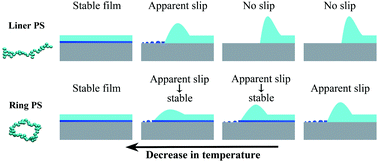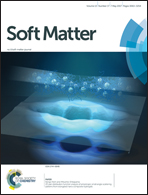The influence of polymer architectures on the dewetting behavior of thin polymer films: from linear chains to ring chains
Abstract
The dewetting behavior of ring polystyrene (RPS) film and linear polystyrene (LPS) film on silanized Si substrates with different grafting densities and PDMS substrate was investigated. Results showed that polymer architectures greatly influenced the dewetting behavior of the thin polymer film. On the silanized Si substrate with 69% grafting density, RPS chains exhibited stronger adsorption compared with LPS chains, and as a result the wetting layer formed more easily. For LPS films, with a decreased annealing temperature, the stability of the polymer film changed from non-slip dewetting via apparent slip dewetting to apparently stable. However, for RPS films, the polymer film stability switched from apparent slip dewetting to apparently stable. On the silanized Si substrate with 94% grafting density, the chain adsorption became weaker and the dewetting processes were faster than that on the substrate with 69% grafting density at the same experimental temperature for both the LPS and RPS films. Moreover, on the PDMS substrate, LPS films always showed non-slip dewetting, while the dewetting kinetics of RPS films switched from non-slip dewetting to slip dewetting behaviour. Forming the wetting layer strongly influenced the stability and dewetting behavior of the thin polymer films.



 Please wait while we load your content...
Please wait while we load your content...